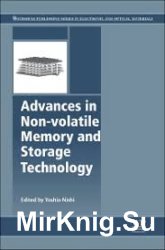
Название: Advances in Non-volatile Memory and Storage Technology
Автор: Edited by Yoshio Nishi
Издательство: Woodhead Publishing
Год: 2014
Формат: PDF
Страниц: 551
Для сайта: litgu.ru
Размер: 39,55 MB
Язык: English
New solutions are needed for future scaling down of nonvolatile memory. Advances in Non-volatile Memory and Storage Technology provides an overview of developing technologies and explores their strengths and weaknesses.
After an overview of the current market, part one introduces improvements in flash technologies, including developments in 3D NAND flash technologies and flash memory for ultra-high density storage devices. Part two looks at the advantages of designing phase change memory and resistive random access memory technologies. It looks in particular at the fabrication, properties, and performance of nanowire phase change memory technologies. Later chapters also consider modeling of both metal oxide and resistive random access memory switching mechanisms, as well as conductive bridge random access memory technologies. Finally, part three looks to the future of alternative technologies. The areas covered include molecular, polymer, and hybrid organic memory devices, and a variety of random access memory devices such as nano-electromechanical, ferroelectric, and spin-transfer-torque magnetoresistive devices.
Advances in Non-volatile Memory and Storage Technology is a key resource for postgraduate students and academic researchers in physics, materials science, and electrical engineering. It is a valuable tool for research and development managers concerned with electronics, semiconductors, nanotechnology, solid-state memories, magnetic materials, organic materials, and portable electronic devices.
Provides an overview of developing nonvolatile memory and storage technologies and explores their strengths and weaknesses
Examines improvements to flash technology, charge trapping, and resistive random access memory
Discusses emerging devices such as those based on polymer and molecular electronics, and nanoelectromechanical random access memory (RAM)